skip to main |
skip to sidebar
Saturday 29th September 2018
As always, I'm overwhelmed by events on this sort of trip and the blog posts quickly slip behind, sometimes emerging late, sometimes not at all. Photographs pose a greater problem since, even when I have internet, it may not be fast enough to upload pictures. This post seeks to give a flavour of Saturday.
I was picked up from the Four Seasons Hotel in Baku, Aberbaijan at the unsocial time of 03:45 to be transferred to Baku Airport and fly by Turkish Air to Instanbul. Flying home via Istanbul was the method recommended by my travel agent so, not having previously been to Istanbul, I decided to stay for two nights and see a little of this important 'city' (I first wrote 'capital', forgetting that Kemal Ataturk promoted Ankara as the new capital in 1923 to mark the end of the Ottoman Empire and the birth of independent Turkey). The flight on an A321-200 was fine and breakfast was served during the journey.

Approaching Istanbul Ataturk Airport (top right) from Baku. The building in the foreground with the low dome is Istanbul Aquarium.
I went through arrival at Instanbul Ataturk airport in possibly a record time (about 35 minutes from 'engines stopped' to exiting the green customs channel with checked bag and hand luggage). I was met by the arranged car to transfer me to my hotel. My agent had recommended a boutique hotel in the centre of the old city called the Levni Hotel and Spa which proved a good choice.
At first, the journey from the airport to hotel was similar to any other large city, using a modern dual carriageway but this changed as we then plunged into an apparently medieval road system built on a hillside comprising narrow, twisting lanes lined with elderly buildings and filled with modern motor vehicles, generally stationary. When vehicles did move, this often seemed to result in 'near misses' with adjacent cars, necessitating urgent horn blowing.

Istanbul: Typical traffic hold-up in the 'Old Town'.
I'm pleased to report that I eventually reached the hotel uninjured. At the hotel, I rejected the tempting plan to catch up on much-needed sleep and, after a shower, explored the hotel facilities. The roof area gave splendid views across the city. My location was in the 'Old Town', near famous locations like Topkapi Palace and Hagia Sophia, part of European Turkey. In one direction, I looked across the Sea of Marmara with Asian Turkey on the other side. The Sea of Marmara is an 'inland sea' as it is entirely within Turkey. To the west, the Sea of Marmara connects via the Dardanelles with the Aegean Sea and the Mediterranean.

Istanbul, Turkey: View from Hotel Levni across the Sea of Marmara with Asian Turkey on the far side.
Turning to my left, I looked at the Bosphorus which connects to the Black Sea (and, beyond that, the Sea of Azov which has become politically sensitive since the Russian Republic completed a bridge to occupied Crimea and compromised shipping movements).

Istanbul, Turkey: View from Hotel Levni looking towards the Bosphorus, with the first of three Bosphorus suspension bridges in the background. A container ship, smaller cargo ship and numerous passenger ferries are visible.
Excited by what I'd seen, I decided to walk the short distance to the waterfront and the ferry terminals at Sirkeci. I'd discussed the Metro system with the friendly male hotel receptionist, who had insisted on lending me his Istanbulkart. This is a credit card which you load with credit which is debited a fixed amount for every tram, metro, bus or ferry journey you make (as is common in many cities). I changed some money into the local currency (Turkish Lira) near the hotel and walked through the narrow streets to the open area near the waterfront where I discovered an information bureau. I obtained a couple of maps so that I could plan a metro journey but the helpful lady assistant offered to walk me to a nearby automatic machine and show me how to obtain my own Istanbulkart so that's what we did. The information office was outside Sirkeci railway station which appears to be reduced to a terminus for a modest electric multiple unit service, served by a modern building. But the original Oriental-Gothic station buildings dating from 1890 have been preserved, although the track which once accommodated the Orient Express service has been shortened and the space gained given over to souvenir sellers.

Istanbul, Turkey: Sirkeci station building dating from 1890 in Oriental-Gothic style.
There's even a small Krauss-built tank engine (or as the Germans say 'tenderlok') plinthed outside.

Krauss 0-4-0T (no. 380 of 1874) plinthed at Sirkeci. TCDD running number 2251.
I discovered later that there's also a one-room museum of railway memorabilia which didn't open during my visit, but I looked in through the windows.
Adjacent to this station, I found the rather temporary-looking entrance to the underground. I'd remembered (from a television documentary) that the TCDD underground line here crossed the Bosphorus using immersed tube construction (the 'Marmaray Tunnel'), so I decided to journey to Uskudar on the Asian side. I made the journey without incident (other than being firmly told by a lady member of the station staff at Sirkeci that photography is not allowed) and emerged at ground level at Uskudar adjacent to a ferry terminal similar to the one at Sirkeci. After taking a couple of pictures, I descended to platform level and travelled back to Sirkeci underground station. I'd started my outward journey via the entrance near the waterfront, going down three escalators to a deep level with long, intermediate level passages. On my return, I deliberately chose a different exit which still had three escalators but which emerged less than 100 yards from my hotel. I was pleased with my initial introduction to Istanbul and it was only 1.00 p.m.

Itinerary of the Bosphorus Cruise displayed in the hotel
On my arrival at the hotel that morning, I'd decided to book an afternoon organised Bosphorus Cruise, in case I lacked the energy (or courage) to do anything on my own so at 1.30 p.m. I was picked up in a small coach, already almost full of passengers. It took us 30 minutes to make our way through the traffic jams to the Golden Horn, passing the imposing Yeni Mosque in the Eminonu district.

17th century Yeni Mosque in Eminonu, Istanbul.
We disembarked at the side of the road and walked to a large tourist boat where well over 100 passengers were already queuing for a buffet style lunch.

Lunch aboard the Bosphorus Cruise vessel
I had almost finished my lunch by the time the last bus had delivered its passengers and we set off on our tour. We passed under the cramped Ataturk Bridge then the modern cable-stayed bridge carrying the Taksim Metro.

Bosphorus Cruise: Ataturk Bridge (with fishermen) and modern cable-stayed bridge serving the Taksim Metro in the background.
Finally, we passed under the famous Galata Bridge and entered the Bosphorus, keeping close to the European shore with public ferries and tour boats everywhere. No larger cargo ships appeared until around 6.00 p.m.

Bosphorus Cruise: Passing a conventional ferry heading for Karakoy Pier, with the Galata Tower in the background.
A commentator identified the major landmarks in English over an effective public address. We passed under the first two Bosphorus Bridges and turned just short of the third bridge with the Black Sea just ahead. The first bridge was opened in 1973, the second in 1988 and the third (which carries a double-track railway in addition to motor traffic) in 2016.

Bosphorus Cruise: The First Bosphorus Bridge.

Bosphorus Cruise: The Second Bosphorus Bridge.
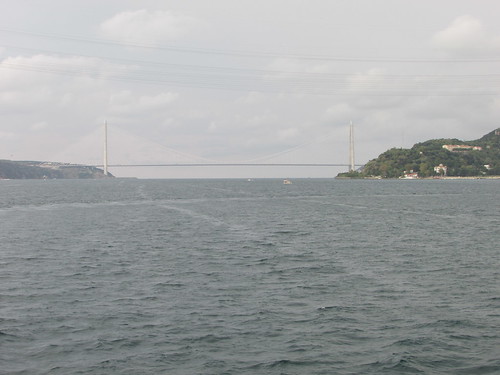 Bosphorus Cruise: The Third Bosphorus Bridge.
Bosphorus Cruise: The Third Bosphorus Bridge.
On the way back we followed the Asian shore, stopping for 30 minutes at the town of Bakoz for a short walk ashore or refreshments.

Bosphorus Cruise: Street scene in Bakoz.
Before turning west to enter the Golden Horn and return to our mooring, we saw the Maiden's Tower, on a small island just off the Asian shore. There's a Wikipedia article here but many people recognise it from its appearance in the James Bond film 'The World is not Enough'. It currently operates as a cafe and restaurant.

Bosphorus Cruise: Maiden's Tower and, on the right, 'Sea Pearl' heading towards the Black Sea.
We arrived back in Istanbul around 6.30 p.m. and, despite the rather primitive arrangements ashore involving walking along temporary paths through building work for a new tram line and queuing at the edge of a busy road as we were allocated to one of a number of coaches, I was soon safely back in my hotel after an absorbing trip.
Related posts on this website
This is the first of a short series of posts describing my weekend in Istanbul.
Clicking on the 'Next report' link displays the post describing the next events. In this way, you may read about the trip in sequence.
Next report
Alternately, clicking on the 'All my Istanbul reports' link displays all the posts on this trip in reverse date-of-posting order.
All my Istanbul reports.
My pictures
Istanbul, Turkey.
Bosphorus Cruise.
Istanbul's Railways.
Istanbul's Metro.
All my pictures in Turkey.
[Text amended, pictures embedded 30/31-Dec-2018: Istanbul trip separated from Caspian Odyssey 7-Jan-2019]
As I mentioned in the last post here, the carefully-choreographed timetable for passing through Georgian border checks, taking dinner in the restaurant car and then passing through Azerbaijan Immigration on the evening of Wednesday, 26th September 2018 didn't quite work.
Thursday 27th September 2018
I awoke to find the train travelling at a leisurely pace through a fairly anonymous-looking plain. There was not much to see except the infrastructure of the double-track electrified railway itself so I had no idea what progress we'd made overnight on our 500 km journey across Azerbaijan to the capital, Baku.
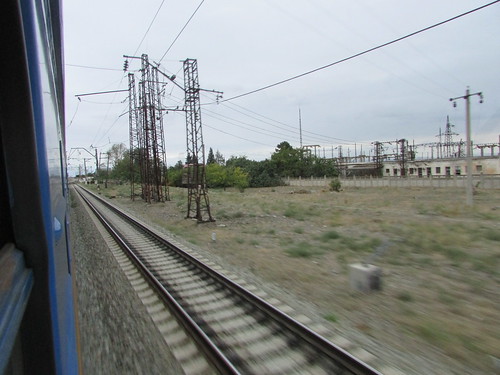
Azerbaijan Railways: Typical railway electricity sub-station.
I took an early breakfast and looked at the passing scene. We had been scheduled to arrive in Baku at eight in the morning and spend the day touring the city. I realised we were going to be late but I didn't expect our arrival to be as late as 4.30 in the afternoon. Unfortunately, we seemed to stop at most of the stations we came to and wait for a while before proceeding. When we were moving, speeds were quite modest, too. I hadn't been able to see very much of the railways in Armenia and Georgia so at least I had more chance to study Azerbaijan's electrified main line, although photography from trains is rarely very satisfactory.
Around eight o'clock, we passed through the station at Ganja, with its mixture of old and modern architecture. The station building was clearly recent but other structures, like a splendid water tower and what I took to be a signal box appeared to date from the steam era.

Ganja Station: Azerbaijan Railways.

Water Tower at Ganja, Azerbaijan Railways.
Only later did I discover that Ganja is Azerbaijan's second largest city, with a population around three-quarters of a million and that it is about 150 km from the border where we'd entered Azerbaijan, leaving some 350 km still to go.
Even reading station names presented something of a problem. Although Latin letters are now commonly used to represent words in Azerbaijan, many signs (including station names) continue to use Cyrillic characters which are quite confusing to Westerners.
By ten o'clock, we were running through Leki station, another modern building, this time with a dome as the stationmaster displayed his short, yellow baton vertically as we passed.

Leki Station: Azerbaijan Railways.
Another half hour brought us to Ucar station, with its extensive sidings. It is situated virtually in the centre of Azerbaijan and I learned later that, whilst the city has a population of perhaps less than 20,000, it forms the administrative centre of the Ujar region with a population approaching 80,000. Our luxury, private train in its distinctive blue livery attracted attention everywhere but the railwaymen around Ucar seemed particularly interested in our passage and my waved greetings received enthusiastic acknowledgment.

Azerbaijan Railways: The crew of an unidentified VL10 locomotive waiting west of Ujar acknowledge our passage.
 Azerbaijan Railways: 2-section, VL11-464A waiting west of Ujar.
Azerbaijan Railways: 2-section, VL11-464A waiting west of Ujar.
East of Ucar station, there were more sidings with waiting freight trains.

Azerbaijan Railways: Westbound freights waiting east of Ucar: VL11 275 on a train of hoppers and an unidentified VL11 on the main line.
About 20 km further on, we passed the small, unrebuilt station of Mususlu, with the stationmaster and, I supposed, all his staff watching the 'Golden Eagle' from the narrow platform.

Mususlu Station: Azerbaijan Railways
Kurdamir was reached after about 40 km. Like Ucar, this is a small city and administrative centre of the Kurdamir Rayon (administrative region) and is provided with a reasonably modern station building, although a number of brick goods sheds and a water tower appeared to be from the steam era.

Azerbaijan Railways: Kurdamir station
Beyond the city, a major highway crossed over the railway next to a modern shopping centre. Nearby were two large, apparently disused, storage buildings which I took to be grain silos served by a number of railway sidings.

Shopping centre in Kurdamir.
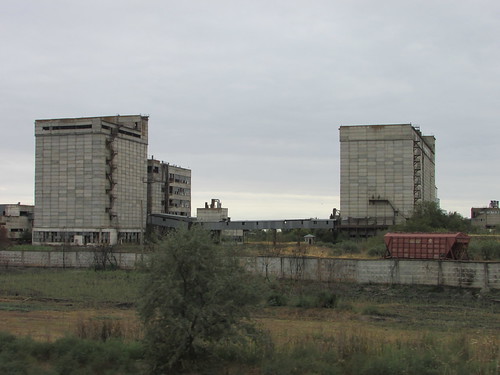
Azerbaijan Railways: Disused grain warehouses at Kurdamir.
Further on, I snatched a picture of another unmodernised but nicely-painted station at Garasu.

Garasu Station, Azerbaijan Railways
We passed what looked like a quarry where a shunting locomotive type TGM23 was parked with a train of bogie hopper wagons.

Azerbaijan Railways: Unidentified shunting locomotive type TGM23 on a train of bogie hopper wagons
The appearance of a number of loops and a waiting westbound electric-hauled freight indicated that we were arriving at yet another small city - Hajiqabul.

Azerbaijan Railways: VL11m 341 waiting with a westbound train west of Hajiqabul.
Major track relaying work was being carried out on the railway here. There was a large tracklaying vehicle at work on the next line and large diesel electric locomotives on various engineer's trains. We were stopped, once again, for about ten minutes and then we crawled slowly past the extensive yards.

Azerbaijan Railways: Track laying machine and 2TE10M-3407 Co-Co diesel electric at Hajiqabul.

Azerbaijan Railways: TEM2 8754 Co-Co diesel electric on Engineer's Spoil Train at Hajiqabul.
Eventually we drew level with the unmodernised station buildings at Hajiqabul, followed by a large double water tower, engineer's sidings and a diesel locomotive maintenance area before finally leaving Hajiqabul behind.

Hajiqabul Station: Azerbaijan Railways
After about 10 km, we passed a tall transmitting antenna on the north of the line and came to a stand in Pirsaat station, with its unmodernised station building almost hidden by mature trees.

Pirsaat station building. Note searchlight and 'Lada' (13:25).
After five minutes, we eased forward, passing a modern diesel electric locomotive waiting on the westbound road and stopped again (near km 117). Five minutes later, we set off slowly, only to halt again after about 1 km. I was frustrated that I couldn't work out exactly what was happening but I concluded that our electric locomotive (which I'd never managed to identify) had been replaced by the modern diesel-electric locomotive I'd seen waiting on the westbound road.
Another 8 km took us to Navahi, where I noted a large cemetery just north of the railway.

Navahi, showing cemetery (13:39)
The station here had substantial, but unmodernised, buildings on the north side of the railway.

Azerbaijan Railways: Navahi station, with the inevitable parked 'Lada' (13:45)
The next station was Atbulaq, about 11 km beyond Navahi. East of the minor station, there was a group of sidings on the north of the main lines in a fenced compound with mainly tank wagons but a few container wagons and a couple of diesel locomotives.

Azerbaijan Railways: Sidings in a fenced compound east of Atbulaq, showing TEM2U 9096 Co-Co diesel electric and unudentified TGK diesel hydraulic shunter, probably both built for industrial use (13:55)
The railway now changed heading: having been running more-or-less south-east, it turned north-east approaching Bash Alat which is around 11 km beyond Atbulaq. On the north of the line, we passed a pre-cast concrete sleeper factory.

Pre-cast concrete sleeper factory, on north side of line, west of Bash Alat (14:03)
We passed what appeared to be a signalling centre on our left just south of the modern station building at Bash Alat on the east of the line and extensive loops on the west. At this point, we were only 2 km from the west shore of the Caspian Sea (although I couldn't yet see it) but still had around 80 km to reach our destination, Baku.

Signalling centre at Bash Alat. Note the two spotlights (14:07)

Bash Alat station bulding on east side of line (14:08)

Bash Alat loops on west of main line. Note the grazing cows (14:09)
Our new heading would enable us to follow the coastline north towards our destination, Baku. After about 14 km, we stopped again at the unmodernised station of Qobustan on the east of the main lines, watched by the young stationmaster and his assistant.

Qobustan Station: Azerbaijan Railways
I was surprised to see a fairly modern electric locomotive type VL11 M6 drawing ahead of us on the platform line and, a few minutes later, a TE33A diesel-electric appeared and stopped in the platform.

Qobustan Station: Azerbaijan Railways: VL11 M6-509 on the platform line. This is a modernised version (built from 1987) of the adaptable multi-section Bo-Bo VL11 (built from 1976) which was developed from the earlier VL10. The Cyrillic 'b' after the running number indicates cab 'b' (14:25)

Qobustan Station: Azerbaijan Railways: TE33A-0292 Co-Co diesel-electric on the platform line (14:25)
After about twenty minutes, our train continued its journey. I decided that the diesel electric which had brought us from Pirsaat had now been replaced by the VL11 M6. About 8 km further north, approaching Sangachal, I could at last see the remarkable Caspian Sea, about 1km distant on our right. A branch line curved away to the shore area with chemical plant, a tank farm and red-painted portal cranes visible.

Approaching Sangachal, showing the non-electrified branch to the dock area visible in the background. Three workmen on the self-propelled Overhead Line Equipment (OLE) maintenance vehicle operated by ATEF Group watch the 'Golden Eagle' pass (14:58)
Our train was diverted to the left-hand track through Sangachal station's single, crumbling platform and we slowly passed a gang of trackworkers working on the other lines.

Sangachal station, showing track maintenance in progress. Four portable hydraulic rail jacks can be seen (15:00)
Continuing beyond the station, we passed Sangachal Power Station on our left - a large, fairly modern electricity generating station which appeared to use multiple diesel generators. The line turned east to keep us within 500 metres of the shoreline.

Sangachal Electricity Generating Station (15:08)
Next, we passed the extensive Sangachal Terminal, also on our left. A useful Wikipedia article here confirms that this oil and natural gas initial processing plant, only started in 1996, is one of the largest in the world. Separators and coalescers separate the incoming product into oil, gas and water before forwarding the oil and gas via pipelines (the Baku-Tbilisi-Ceyhan pipeline to Turkey's Mediterranean coast and the Baku–Novorossiysk pipeline to Russia's Black Sea coast).

Sangachal Terminal, Azerbaijan (15:09)
I was fascinated by the multi-coloured but barren hillside which appeared on our left. Only later did I confirm that this resulted from the outpourings of a mud volcano from the Wikipedia article here. Azerbaijan, with over 400, hosts more than half of the world's known mud volcanoes.

Mud Volcano, north of Sangachal, Azerbaijan (15:16)
When I saw a rail yard on our left with lines of bogie tank wagons, I initially assumed that they were oil tankers but the nature of the industrial plant which appeared next (and the dusty landscape) quickly convinced me that they were bulk cement wagons. A large kiln labelled 'Holcim' confirmed that we were passing a cement works. There's an interesting history of the plant on the Holcim Azerbaijan site here. The plant was set up by the Soviet Union in 1949 to support the post-war building programme. Following the collapse of the Soviet Union, the plant was privatised in 1999 and acquired by Holcim, becoming part of LafargeHolcim in 2015.

Azerbaijan Railways: Passing Holcim Cement Plant, Garadagh, heading for Baku (15:19)
We stopped, yet again, at Garadagh station, on the main line with a platform loop on our right and unmodernised but painted station buildings. After a wait of around five minutes, we quietly set off again.

Garadagh Station, Azerbaijan Railways (15:27)
A developed industrial area appeared on our right. The lines of bogie tank wagons were certainly for oil products this time - in the yellow and black livery of 'SOCAR'. The State Oil Company of the Azerbaijan Repulic ('SOCAR') was set up in 1992, following the demise of the Soviet Union, to manage the oil and natural gas resources of Azerbaijan. There's a website here. Baku Shipyard, in the background of the picture below, was originally set up in 2010 as a joint venture between SOCAR (65%), Azerbaijan Investment Company (25%) and established shipbuilders Keppel from Singapore (10%).

Azerbaijan Railways: Yellow and black 'SOCAR' oil tankers and, in the background, Baku Shipyard (15:41)
Our train then passed the reason for the lines of tank wagons - the Garagdah Methanol Plant which started production in 2013 as the Azerbaijan Methanol Company but is now operated by SOCAR.

Garagdah Methanol Plant (15:42)
To recap our journey, since entering Azerbaijan our train had crossed the country heading roughly south east, to approach the Caspian sea near Bash Alat, then headed north for around 20 km to Sangachal then continuing about 20 km north east. Baku itself is located on a large promontory, shaped a little like a parrott's head, which projects into the Caspian Sea around 50 km. The city of Baku is built on hills around a south-facing bay. The railway does not approach the centre of Baku directly but turned away from the coast, threading its way through the hills around Garagdah and passing through a bleak moonscape populated by small oil drilling rigs with a number of 'nodding donkey' pumps still extracting the product.

Azerbaijan Railways: View approaching Lokbatan, showing oil derricks and 'nodding donkey' pumps (clear example near top left) (15:45)
The line then turned east, running along the shore of a lake with the residential district of Lokbatan spread out across the hills to the north.

Azerbaijan Railways: Lokbatan, viewed from the 'Golden Eagle' (15:48)
Once through Lokbatan station we were about 3km from the shore on our right but I snatched a picture of seven offshore drilling rigs awaiting their next commission as we passed two modern warehouse complexes on our left - Abseron Port and Baku Logistics centre.

Azerbaijan Railways: Offshore drilling platforms awaiting their next commission, L: 6 off 'Jack-up', R: 1 off 'Semi-submersible' (15:51)

Azerbaijan Railways: Crossing Keeper's Hut on access road to Baku Logistics Centre with unidentified TEM3 Co-Co diesel electric moving a train from the sidings at Abseron Port. The bogie timber wagons carry sawn timber planks, carefully loaded to fill the loading gauge (15:53)
Beyond Heybat station, the line headed north through a river valley and past Khojahasan Lake before coming to the major railway junction of Bilacari where the main line from the Russian Federation to the north joins. We headed east for around 5 km, through the extensive marshalling yards of Bilicari, then continued another 5 km south-east through the district of Bakmi with a smaller freight yard and a station with an island platform.

Azerbaijan Railways: Unidentified VL11, bucket excavator on rail wagon and VL10-1031, Bakmi district, near Baku (16:18)
The line turned again so that we were heading due west as we crossed Heydar Aliyev Avenue and, almost at our destination, were halted for six minutes before finally crawling into the main platform at Baku, over eight and a half hours late.
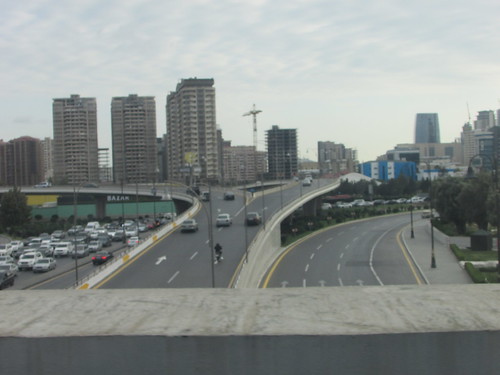
Azerbaijan Railways: View of road junction on Heydar Aliyev Avenue and Babek Avenue, looking south (16:32)
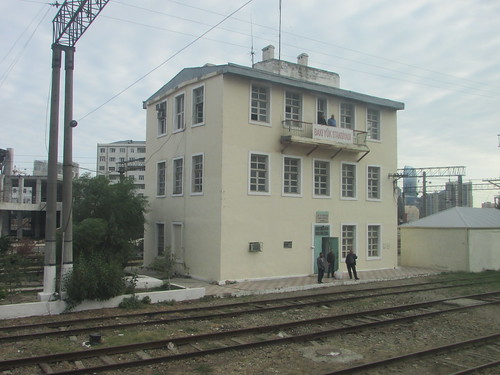
Azerbaijan Railways: The arrival of the Golden Eagle' in Baku watched from the signalling centre (16:33)
Guests lost no time leaving the train after our marathon journey from Tbilisi. I didn't get to see the historic station building because we were shepherded through a side entrance to where a number of modern coaches were waiting to pick us up.

Azerbaijan Railways: Guests disembarking from the 'Golden Eagle' on arrival at Baku (16:38)
Related posts on this website
This is one of a series of posts describing my 'Golden Eagle' Caspian Odyssey trip, starting with Travelling East.
Clicking on the 'Next report' link displays the post describing the next events. In this way, you may read about the trip in sequence.
Next report.
Alternately, clicking on the 'All my Caspian Odyssey reports' link displays all the posts on this trip in reverse date-of-posting order.
All my Caspian Odyssey reports.
My pictures
These albums include pictures of the above events:-
Azerbaijan Railways.
All my pictures taken in Azerbaijan (except 'technical' railway pictures) are in the collection Azerbaijan.
[Links to pictures added 10-Oct-2018: Text amended 31-Oct-2018: Pictures embedded 1/2-Nov-2018: Text and pictures added 8/13-Nov-2018]













 Bosphorus Cruise: The Third Bosphorus Bridge.
Bosphorus Cruise: The Third Bosphorus Bridge.















































